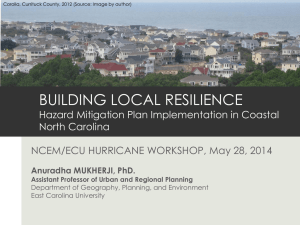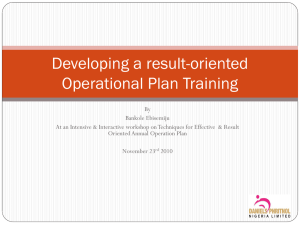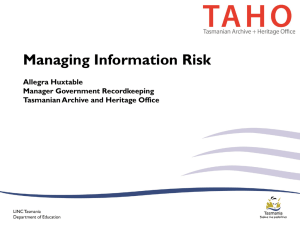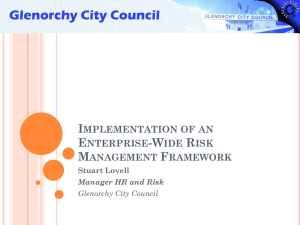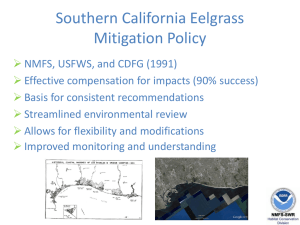Mitigation Presentation
advertisement
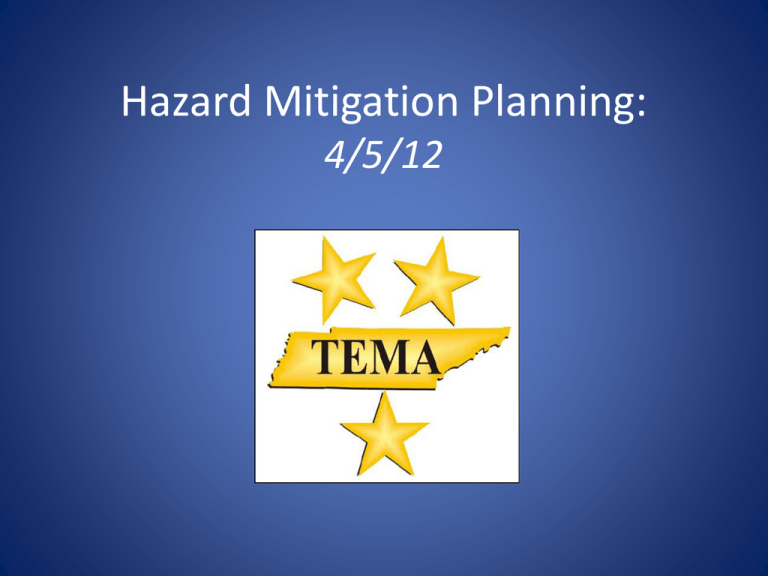
Hazard Mitigation Planning: 4/5/12 Who We Are TEMA Mitigation Planning • Josh Wickham (Middle & East TN) Planner • Michael Caudill (West TN) Area Coordinator – Craig Hanrahan Planning Supervisor TEMA Mitigation Grants • Judy Huff State Hazard Mitigation Officer – Mary Lynn Gillingham, Donna Holden, & Billy Harper Grant Managers Presentation Agenda • Hazard Mitigation Planning • TEMA’s 3 Phase Approach: TMI • How Utilities Can Get Involved Pillars of Emergency Management Define • Hazard Mitigation – any sustained action taken to reduce or eliminate the long term risk to human life and property from hazards Preparedness / Response • • short-term fix prepares humans to respond Mitigation • • • long-term fix can reduce property damage project/program does much of the response work itself Flooding: Lincoln County, TN Tornado: Lake County, TN Earthquake: Shelby County, TN Flooding: Bradley County, TN Define • Hazard Mitigation Plan – a single or multi-jurisdictional planning document that profiles specific hazard risks & vulnerabilities and then addresses & prioritizes potential mitigation projects that can reduce those specific vulnerabilities. How Did Mitigation Plans Come About? • Prior to 2000: Reactive • After 2000: Proactive – Planning/Plans = Proactive Disaster Mitigation Act of 2000 this law is what requires state and local governments to prepare FEMAapproved HZMIT plans for eligibility to participate in hazard mitigation grant programs Mitigation Grant Program • Hazard Mitigation Grant Program (HMGP) • Pre-Disaster Mitigation Program (PDM) • Flood Mitigation Assistance Program (FMA) • Repetitive Flood Claims Program (RFC) • Severe Repetitive Loss Program (SRL) Pass all approximately 40 Requirements = FEMA Approved Local Gov.- 5 year planning cycle State Gov.- 3 year planning cycle HZMIT Plan Components 1. Planning Process 2. Risk Assessment 3. Mitigation Strategy 4. Plan Maintenance 1. Planning Process – How the plan was prepared – What steps were taken to develop the plan – What existing data sources were reviewed – Who was involved in the planning process Committee List -who was involved Planning Process Steps -when meetings occurred -what tasks were completed by whom & when -how the planning process was conducted Public Involvement -how public was informed Review of Sources -data sources -existing local codes/plans Updates to Previous Plan -how each section was updated -why each section was updated or not 2. Risk Assessment Hazards – Profiling what hazards affect which areas – Describing previous hazard occurrences Hazard Characteristic – Addressing the strength and probability of the hazards – Describing possible impacts the hazards could cause on the community’s businesses, environments, structures, critical facilities, and persons Vulnerabilities – Determining the community’s most vulnerable structures, populations, and infrastructure to hazard impacts Describing Possible Impacts Determining Most Vulnerable Areas Gen. Description of Hazard -how hazard comes about, etc. Probability Extents & Hazard Scales -Intensity Scales -Worst Case Scenarios Previous Occurrences -Locations, Dates, Extents Deaths/Injuries, Property Damages Maps Hazard Event Descriptions -Past Impacts & Damages Risk Assessments Areas of Prime Concern Statistical Assessments 3. Mitigation Strategy – Determining goals/projects to reduce the most vulnerable areas identified – Describing funding sources, timeframes, and project management details – Placing a focus on costeffectiveness of the mitigation projects – Prioritization of the projects Goals Project Prioritization -Methodology to prioritize projects by factors such as current resources, cost-effectiveness, community support, etc. Project Listing -Name of Project -Project Details: Responsible Agency, Possible Funding Sources, Timeframe -Project Priority Ranking Updates to Previous Plan -Status of Projects: completed, deleted, deferred and how/why 4. Plan Maintenance – How to keep the plan a living breathing document to be continually updated and implemented How will the plan be: -Monitored -Evaluated -Updated Presentation Agenda • Hazard Mitigation Planning • TEMA’s 3 Phase Approach: TMI • How Utilities Can Get Involved TEMA’s 3 Phase Approach Tennessee Mitigation Initiative An outreach initiative developed after the May 2010 Floods to promote, strengthen, and support statewide mitigation actions. TMI Phase 1: All Counties to have an FEMA-Approved HZMIT Plan status: in progress HZMIT Plan Status: August 2010 • Focus: Phase 1 – Assist Presidentially-Declared Disaster Counties Develop New Hazard Mitigation Plans First • Since all of West TN had plans, our strategy was to begin in Middle TN and work our way through East TN • Challenges: – A large amount of County EMA Directors are part-time, voluntary, or were fully immersed in the May 2010 flood recovery, that they therefore had little time to write a plan from scratch – A large amount of EMA Directors had knowledge of disaster preparedness, response, & recovery, but not mitigation – Mitigation plans require meeting lots of technical regulations that many local governments don’t have the training or resources needed to complete – Even with grants available, some counties couldn’t hire planning consultants because of the financial strain of the grant’s required local match Phase 1 Created the “HZMIT Tool Program”: a program designed to provide a no-cost, no-headache approach to assisting local governments in developing hazard mitigation plans VS. Step 1 of 3: Databases/Studies Step 2 of 3: Discussions/Fill in the Blanks Step 3 of 3: Simple Check List • Hold additional meetings where at least one is advertised in the newspaper to give the public a chance to participate – TEMA will not be present at these meetings • Choose Mitigation Projects; Prioritize Projects HZMIT Tool Shell HZMIT Plan Status: August 2010 HZMIT Plan Status: April 2012 • 42 Plans approved for longer than two years (compared to 8 in 2010) • 6 Plans in FEMA Review • 26 Plans between 60-90% complete • Approximately 75 Community Assistance Workshops in Mid. & East TN along with additional assistance West TN Phase 1 Additional Goals • 1.1- Assist Local Governments in Enhancing Risk Assessment Data for previously Presidentially-Declared Disaster Hazards in TN – Flooding, Severe Storms, Hail, Straight-line Winds, Tornados, Winter Storms, Freezes Simplified Floodplain Maps #23 HAZUS Flood Runs Phase 1 Additional Goals • 1.2- Inform Local Governments about Mitigation Grants during the Planning Process – creates more useful plans & planning upfront Phase 1 Additional Goals • 1.3- Promote the bringing together of two different professions into the local mitigation planning process – community development professionals • built-environment: highways, utilities, public works, code enforcement, community planning, etc. – emergency management professionals • emergency services: fire, police, EMS, etc. TEMA asks County EMA Directors to get community development professionals involved; County EMA sets up the meetings and invites TMI Phase 2: Revamp the State of TN HZMIT Plan status: initial stage Phase 2 • Focus: Updating the State’s Risk Assessment and Strategies – placing an emphasis on flood & earthquake studies • TEMA has secured a planning grant to get contracted assistance in revamping the plan • TEMA will be working the Office of Information Resources to complete a GIS-based risk assessment of state government facilities • TEMA will work with other professionals, agencies, & academia to incorporate information from reports, interviews, & studies into the plan – includes “Seismic Risk Assessment for West TN Public Water Systems” Report Phase 2 Additional Goal • 2.1- Develop a new additional “HZMIT Tool Program” that focuses on plan updates – Four Counties in Middle TN have used it successfully thus far – Focuses on providing additional detailed risk assessment information and reorganizing mitigation projects – Provide the new tool as another assistance option to East and West TN Counties TMI Phase 3: Enhance Mitigation Planning Resources status: brainstorming stage Phase 3 • Assist Local Governments in Enhancing Risk Assessment Data for Non-Presidentially Declared Disaster Hazards in TN – Earthquakes, Landslides, Wildfires, etc. • Creation of How-to Guides and Pilot Programs – Potential Examples • • • • Using GIS Spatial Analysis in Risk Assessments Special Mitigation Actions for Historically Significant Buildings Using Zoning, Codes, or Incentives toward Mitigation Goals Etc. • Suggestions/Ideas??? Presentation Agenda • Hazard Mitigation Planning • TEMA’s 3 Phase Approach: TMI • How Utilities Can Get Involved Why Utilities Should Be Involved • Utility systems represent a “Critical Facility / Function”; therefore they need to remain as functional as possible during times of emergency – Mitigation can assist with these efforts • Utility personnel have knowledge of structures and potential vulnerabilities that Emergency Managers don’t have – This information should be incorporated into mitigation planning and other EMA efforts Why Utilities Should Be Involved • To be eligible to receive FEMA Mitigation Grants, Utilities Districts will need to be involved in the Local Government Mitigation Planning Processes and have potential projects, (especially if they would require FEMA mitigation grants), listed in the local plan • Involved: be documented in a meeting sign-in sheet & contribute to the basic risk assessment (write up could be as little as ½ a page) • Project(s) listed in the Local Plan: When applying for FEMA Mitigation Grants, the first two things FEMA looks for are: – Does the community have an Approved Hazard Mitigation Plan? – What page number is the project seeking grant funding listed on in the plan? (Note: FEMA requires minimal project details in the plan, the majority of project details are to be found in the grant application. How to Get Involved 1. Contact your County’s EMA Director – TEMA provides assistance, but local governments are the coordinators – EMA Directors make up approximately 95% of mitigation plan coordinators, but a few cities/counties have water services, community planning, and other departments as their coordinators – Google search “____ County TN Emergency Management” to find EMA Director’s Contact Information How to Get Involved 2. Tell County EMA Director that your Utility District would like to become a member of the Mitigation Plan Committee and attend future planning meetings – Note: Many communities have just recently completed their new plans or updates, therefore many committee meetings may not be held for a while – If updates to the plan won’t take place for a while, plan “revisions” can be submitted to FEMA Presentation Agenda • Hazard Mitigation Planning • TEMA’s 3 Phase Approach: TMI • How Utilities Can Get Involved Thank You! Any Questions???




